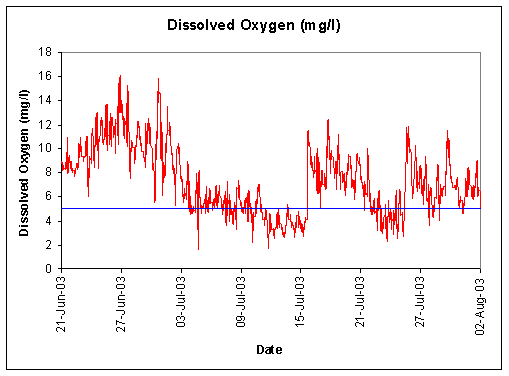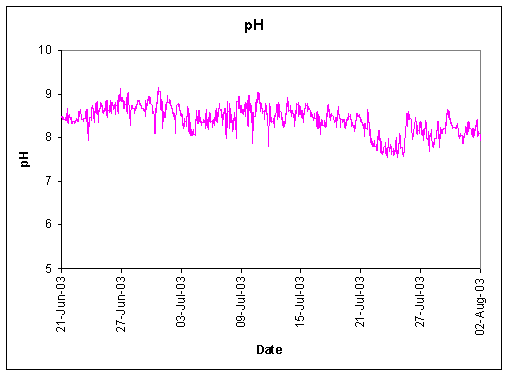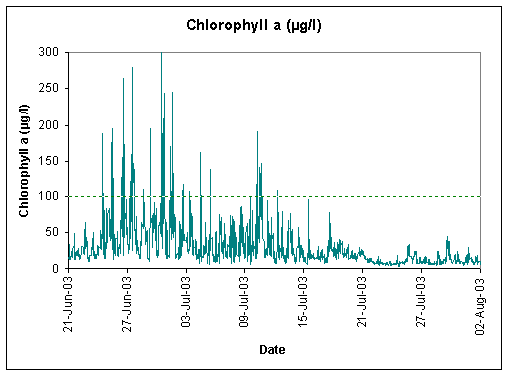"Black Tide Bloom" in Lower Patuxent
River
Algal blooms can affect local water quality and have tremendous impacts on living
resources. Algae are present in the water all year round. However, in the cooler
months of the year their population numbers (measured as the number of cells
per ml of water) are low. As the waters warm in the spring and summer months
of the year, algae begin to undergo natural population increases, known commonly
as blooms. The level of these blooms can be exacerbated by the presence of excess
nutrients in the water. This problem is known as eutrophication and is a common
problem in the Chesapeake and Coastal Bays.
When algae bloom, oxygen levels in the water increase initially as oxygen is
produced by the algae through the process of photosynthesis. Oxygen levels may
decline on cloudy days and at night as more oxygen is consumed (known as respiration)
than is produced by the algae. The processes of photosynthesis and respiration
can also cause increases in the pH of the water. The amount of chlorophyll (a
photosynthetic pigment) in the water increases as the number of algae in the
water increase. As the algae die and begin to decompose, oxygen levels tend
to plummet. This decline in oxygen levels can have detrimental impacts on living
resources and will occasionally result in fish kills.
 The
effects of localized algal blooms on water quality are routinely captured by
Continuous
Monitoring Data. During the summer months of 2003, a bloom of Karlodinium
micrum (also known as "black tide") occurred in the lower
Patuxent River. The continuous
monitoring station on the Patuxent River at the Chesapeake Biological Laboratory detected the initial increases in dissolved oxygen and pH associated with this
bloom between the 21st and 27th of June (Figures
1 & 2). Increases in chlorophyll were
also detected over this time period (Figure 3).
Between June 27th and July 3rd the Karlodinium bloom reached its highest
concentrations and then died off, causing oxygen levels in the river to drop
below 5 mg/l. The bloom continued over the following weeks and intensified again
after July 9th. Once again, oxygen levels increased temporarily, then dropped
below 5 mg/l as the bloom died off. Luckily, only a few small fish and crab
kills were observed during these periods of low dissolved oxygen.
The
effects of localized algal blooms on water quality are routinely captured by
Continuous
Monitoring Data. During the summer months of 2003, a bloom of Karlodinium
micrum (also known as "black tide") occurred in the lower
Patuxent River. The continuous
monitoring station on the Patuxent River at the Chesapeake Biological Laboratory detected the initial increases in dissolved oxygen and pH associated with this
bloom between the 21st and 27th of June (Figures
1 & 2). Increases in chlorophyll were
also detected over this time period (Figure 3).
Between June 27th and July 3rd the Karlodinium bloom reached its highest
concentrations and then died off, causing oxygen levels in the river to drop
below 5 mg/l. The bloom continued over the following weeks and intensified again
after July 9th. Once again, oxygen levels increased temporarily, then dropped
below 5 mg/l as the bloom died off. Luckily, only a few small fish and crab
kills were observed during these periods of low dissolved oxygen.

| Figure 1. Dissolved oxygen levels from the Patuxent
River continuous monitoring station at the Chesapeake Biological Laboratory
(6/21/03 - 8/2/03). |

| Figure 2. pH levels from the Patuxent River continuous
monitoring station at the Chesapeake Biological Laboratory (6/21/03 -
8/2/03). |

| Figure 3. Chlorophyll-a levels from the Patuxent River
continuous monitoring station at the Chesapeake Biological Laboratory
(6/21/03 - 8/2/03). |
 Print This Page
Print This Page Print This Page
Print This Page The
effects of localized algal blooms on water quality are routinely captured by
Continuous
Monitoring Data. During the summer months of 2003, a bloom of Karlodinium
micrum (also known as "black tide") occurred in the lower
Patuxent River. The continuous
monitoring station on the Patuxent River at the Chesapeake Biological Laboratory detected the initial increases in dissolved oxygen and pH associated with this
bloom between the 21st and 27th of June (Figures
1 & 2). Increases in chlorophyll were
also detected over this time period (Figure 3).
Between June 27th and July 3rd the Karlodinium bloom reached its highest
concentrations and then died off, causing oxygen levels in the river to drop
below 5 mg/l. The bloom continued over the following weeks and intensified again
after July 9th. Once again, oxygen levels increased temporarily, then dropped
below 5 mg/l as the bloom died off. Luckily, only a few small fish and crab
kills were observed during these periods of low dissolved oxygen.
The
effects of localized algal blooms on water quality are routinely captured by
Continuous
Monitoring Data. During the summer months of 2003, a bloom of Karlodinium
micrum (also known as "black tide") occurred in the lower
Patuxent River. The continuous
monitoring station on the Patuxent River at the Chesapeake Biological Laboratory detected the initial increases in dissolved oxygen and pH associated with this
bloom between the 21st and 27th of June (Figures
1 & 2). Increases in chlorophyll were
also detected over this time period (Figure 3).
Between June 27th and July 3rd the Karlodinium bloom reached its highest
concentrations and then died off, causing oxygen levels in the river to drop
below 5 mg/l. The bloom continued over the following weeks and intensified again
after July 9th. Once again, oxygen levels increased temporarily, then dropped
below 5 mg/l as the bloom died off. Luckily, only a few small fish and crab
kills were observed during these periods of low dissolved oxygen.